#rpg combat techniques
Text
Fitting Martial Arts into your Palladium Megaverse game
Discover how to blend martial arts into any Palladium Megaverse setting! 🥋 Our video guide dives deep into integrating combat skills that will bring your RPG to life. 🌐 Join the adventure!
#PalladiumRPG #MartialArts
Ninjas & Superspies
Step into the vast realms of the Palladium Megaverse, where martial arts breathe life into every corner of your adventures. This video offers a detailed overview of fitting various martial arts into any setting within the Palladium Books universe, from the gritty streets of Rifts to the mystical lands of Fantasy. Enhance your campaigns with expert tips on incorporating…
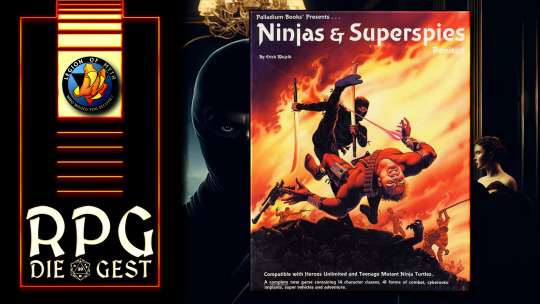
View On WordPress
#character skills rpg#legion of myth#martial arts in gaming#martial arts rpg#megaverse campaigns#megaverse settings#ninjas & superspies#ninjas and superspies review#ninjas in rpgs#Palladium Books#Palladium Fantasy#palladium game tutorials#palladium megaverse#palladium rpg strategies#Palladium universe#role-playing game guides#role-playing games#rpg character development#rpg combat techniques#rpg game design#rpg game mechanics#superspies game#tabletop combat#tabletop gaming tips#tabletop RPG
1 note
·
View note
Text
ISAT and Ludonarrative Harmony: Combat is a Storytelling Tool
Or: How Siffrin is stuck in the endgame grind, forever
Please Note: This is primarily aimed at an audience that already played In Stars and Time, because I am bad at explaining things, and it's good to already know what the fuck I'm talking about. I tend to only bring up game elements as I want to talk about them.
Spoilers for.... all of ISAT! Especially Act 5!

(image to show how i feel posting this and as an attention grabber over my wall of text)
To pull a definition of ludonarrative harmony out of a hat, game writer Lauryn Ash defines it as follows:
Ludonarrative harmony is when gameplay and story work together to create a meaningful and immersive experience.
From a design implementation perspective, it is the synchronized interactions between in-game actions (mechanics) and in-world context (story).
It is, generally speaking, how well game mechanics work hand in hand with the story. I, personally, think ISAT is an absolute masterclass of it, so I want to take a look at how ISAT specifically uses its battle system to emphasize Siffrin's character arc and create organic story moments. I want you to keep this in mind when I talk here.
So, skills, right? If you've played any turn-based RPG, you know your Fire spells, your "BACKSLASH! AIRSLASH! BACKSLASH!" and the many ways to style those.
Well, what does casting "Fire" say about your character? Not all that much, does it? Perhaps you'll have typical divisions. The smart one is the mage, the big brawny one is your tank, the petite one's the healer. And that's the barebones of ISAT's main party, but it's much more than that.
Every character's style of combat tells you something about them. Odile, the Researcher, is the most well-travelled and knowledgable of the bunch. She's the one with the expertise to keep a cool head and analyze the enemy, yet also able to use all three of the Rock-Paper-Scissors craft types.
To reflect her analytical view of things, all her skill names are just descriptive, the closest to your most bog-standard RPG. "Slow IV" or "Paper III" serve well to describe their purpose. The high number of the skills gives the impression there were three other Slow skills beforehand - fitting, considering the party starts at level 45, about to head into the final dungeon. She's also the oldest, so she's the slowest of the bunch.
Isabea, the Fighter, has all his skills in exclamation points. "YOUR TURN!!!" "SO WEAK!!!" "SMASH!!!" they're straightforward, but excited. He's a purposefully cheerfull guy, so his skills revolve around cheering on his allies. He's absolutely pumped to be here, and you see that from his skill names alone.
Mirabelle, the Housemaiden, is an interesting case. She's by all means the true protagonist of this tale - She's the one "Chosen by the Change God," the only one who survived the King's first attack, the only one immune to his ability to freeze time, the only dual-craft type of the game - just a lot of things. And her skill names reflect that facade she puts on herself - she can do this, she can win! She has to believe it, or else she starts doubting. This is how you get "Jolly Round Rondo" and "Mega Sparkle Heal" or "Adorable Moving Cure." She's styled every bit a sailor scout shojo heroine, and her moveset replicates the naming conventions of "In the name of the moon, I'll punish you!"
Even Bonnie, the Kid, who can't be controlled in combat, has named craft skills. And they very much reflect that Bonnie is, well, a kid. "Wolf Speed Technique" or "Thousand Blows Technique" are very much the phrasings of a child who learned one complicated word and now wants to use it in everything to seem cooler than they are, which is none, because they're twelve.
Siffrin's skills are all puns.
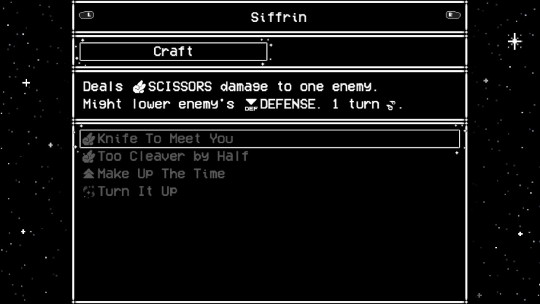
You have an IMMEDIATE feel for personality here. Between "Knife to Meet You!" and "Too Cleaver by Half," you know Siffrin's the type to always crack a joke no matter the situation, slinging witticisms around to put Sonic the Hedgehog to shame. It's just such a clever way to establish character using a game mechanic as old as the entire history of RPGs.
This is only the baseline of the way the combat system feeds into the story, though.
The timeloop, of course, feeds into it. Siffrin is the only character who retains experience upon looping, whereas all other characters are reset to their base level and skills. And it sucks (affectionate).
You're extremely likely to battle more often the earlier in the game you are - after all, you need the experience (for now.) Every party member contributes, and Siffrin isn't all that strong on their own, since they focus on raw scissor type damage with the addition of one speed buff. (Of course it's a speed buff. They're a speedy fucker. Just look at him).
At first, the difference in level between Siffrin and the rest of the group is rather negligible. Just a level or two. Just a bit more speed and attack. And then Siffrin grows further and further apart. Siffrin keeps learning new skills. He gets a healing skill that doubles as an attack boost, taking away from both Mirabelle's and Isabeau's usefullness. He gets Craft skills of every type that even give you two jackpot points instead of one - thus obliterating Odile's niche. Siffrin turns into a one-person army capable of clearing most encounters all on their own.
Siffrin's combat progression is an exact mirror of story progression - as their experience inside the loops grows, they also grow further and further away from their party. The party seems... weaker, slower, clumsier. Always back at their starting point, just as all of their character arcs are reset each loop. Never advancing, always stagnant. And you have Siffrin as the comparison post right next to them.
I also want to point out here a change from Act 2 to Act 3 - Siffrin's battle portrait. He stops smiling.

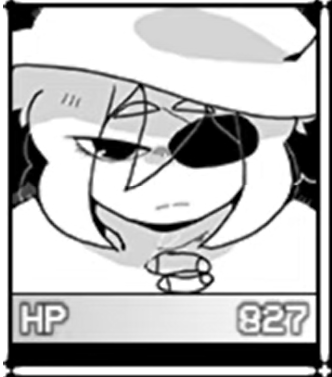
Battles keep getting easier. This is true both for the reason that Siffrin keeps growing stronger even when all enemies stay the same, but also for the reason that you, the player, learn more about the battle system and the various encounters, until you've learned perfect boss clear strategies just from repetition. Have you ever watched a speedrunner play Pokemon? They've played this game so many times, they could do it blindfolded and sleeping. Your own knowledge and Siffrin's new strength work in tandem to trivialize the game's entire combat system as the game progresses.
(Is it still fun? Playing it over, and over, and over again? Is it?)
You and Siffrin are in sync, your experience making everything trivial.
As time goes on, Siffrin grows to care less and less about performing right for their party and more and more about going fast. A huge moment in his character is marked by the end of Act 3; because of story events I won't delve too deeply into, Siffrin has grown afraid of trying something new. And his options of escape are closing in. They need an answer, and they need it fast. He doesn't have the time or patience to dumb himself down, so you unlock one new skill.
It doesn't occur with level up, or with a quest, or anything at all. At the start of Act 4, it simply appears in Siffrin's Craft skills.
(Just attack.)
No pun. No joke. Just attack. Once you notice, the effect is immediate - here you have it, a clear sign of how jaded Siffrin has become, right at every encounter. And it's a damn good attack, too! The only available attack in the game that deals "massive" damage against all enemies. Because it doesn't add any jackpot points (at least, it's not supposed to), you set up a combo with everybody else, but Siffrin simply tears away at the enemy with wild abandon. Seperated from the rest of the party by the virtue of no longer needing to contribute to team attacks (most of the time. It's still useful if they do, though).
Once again, an aspect of the battle system enhances the degree of separation between Siffrin and the static characters of his play. You're incentivized to separate him, even.
Additionally, there are two more skills to learn. They're the only skills that replace previous skills. You only get them at extremely high levels, the latter of which I didn't even reach on both of my playthroughs.
The first, somewhere in the level 70 range, Rose Printed Glasses, a paper type craft skill, is replaced by Tear You Apart. It's still a pun about paper, but remarkedly more vicious.
The second is even more on the nose. At level 80, In A While, Rockodile!, a rock type craft skill, is replaced by the more powerful Rock Bottom.
I didn't get to level 80. If you do, you pretty much have to do it on purpose. You have to keep going much longer than necessary, as Siffrin is just done. And the last skill he learns is literally called Rock Bottom.
What do I even need to say, really.
Your party doesn't stay static forever, though.
By doing their hangout quests, side quests throughout the loops that result in Siffrin and the character having a heart to heart, all of them unlock what I'd call an "ultimate" skill. You know the type - the character achieved self-fulfillment, hit rank 10 on their confidant, maxed out their skill tree, and received a reward for their trouble.
These skills are massively useful. My favorite is Odile's - it makes one enemy weak to all Craft types for several turns, which basically allows you to invalidate the first and third boss, as well as just clown on the King, especially once Siffrin starts racking up damage.
But the thing is. In Act 3, when you first get them, yeah, they're useful. But... do you need them? After all, they're such a hassle to get. You need to do the whole character quest again, you can't loop forward in the House or you'll lose them. If you want to take these skills to the King, you need to commit. Go the full nine-yards and be nice to your friends and not die and not skip forward or skip back. Which is annoying, right?
Well, I sure did think so during Act 4. After all, a base level party can still defeat the King, just with a few more tricky pieces involved. Siffrin can oneshot almost all basic enemies by the time of Act 4. It's this exact evalutation that you, the player, go through everytime you return to Dormont. Do I want this skill, still? Would it not be faster to go on without it? I'm repeating myself, but that's the thing! That's what Siffrin is thinking, too!

I also want to take a quick moment to note, here - all skills gained from hangouts have art associated with them, which no other skills do. This feature, the nifty art, hammers home these as "special" skills, besides just how they're unlocked.
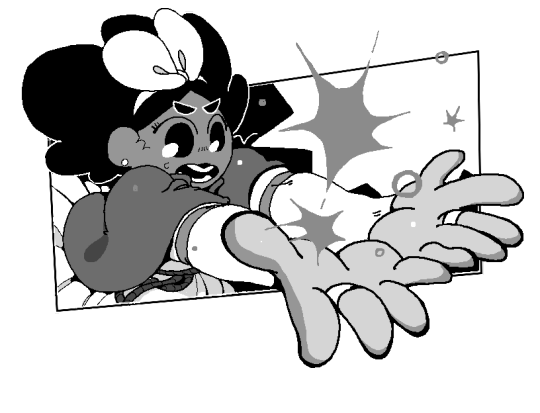
Siffrin also has one skill with associated art.
Yeah, you guessed it, it's (Just attack.)
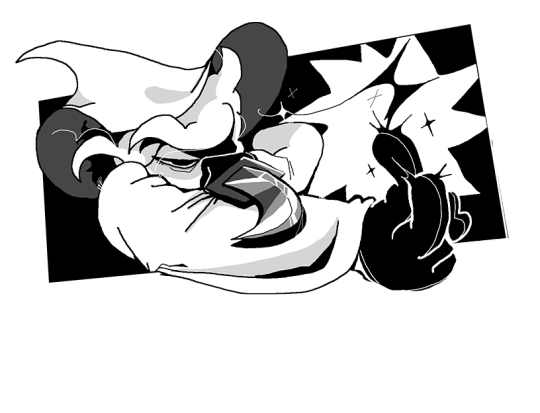
At first, helping the characters is tied to a hefty in-game reward, but that reward loses its value, and in return devalues helping Siffrin's friends every loop. It's too tedious for a skill that'll make a boss go by one turn faster. You, the player, grow jaded with the battle system. Grinding experience isn't worth it, everybody's highest levels are already recorded. Fighting bosses isn't worth it, it's much faster to loop forward.
Isn't this what all endgame in video games looks like? You already beat the final boss, and now... what challenge is left? Is there a point to keep playing? Most games will have some post-game content. A superboss to test your skills against, but ISAT doesn't have any of that. You're forever left chasing to the post-game. That's the whole point - to escape the game.
As most games get more difficult as time passes, ISAT only gets easier. The game becomes disinterested in expanding its own mechanics just as I ran out of new things to fight after 100%-ing Kingdom Hearts 3. Every encounter becomes a simple game of "press button to win."
The final boss just takes that one up a notch.
Spoilers for Act 5 ahead boys!
In Act 5, Siffrin utterly loses it. His last possible hope for escape failed him, told him there's nothing she can do, and Siffrin is trapped for eternity. So of course, they go insane and run up the entire House without their party.
This just proves what you already knew - you dont need the party to proceed. Siffrin alone is strong enough. And here, Siffrin has entirely shed the facade of the jokester they used to be. Every single skill now follows the (Just attack.) naming conventions. Your skills are: (Paper.) (Rock.) (Scissors.) (Breathe.)

To the point. Not a moment wasted, because Siffrin can't take a moment longer of any of this. Additionally, his level is set to 99 and his equipment becomes fixed. You can't even pick up items anymore! Not that you needed them at this point anyway, right? Honestly, I never used any items besides the Salty Broth since Act 2, so I stopped picking items up a long time ago. Now you just literally can't.
Something I've not talked about until now - one of the main equipment types in this game are Memories, gained for completing subquests or specific interactions and events. They all by and large have little effects - make Odile's tonics heal more, or have Mirabelle cast a shield at the start of combat. For the hangout events, you also gain an associated memory that boosts the characters' stats by 30. It lets them keep up with Siffrin again! A fresh wind! Finally, your party members feel on par with you again!
...For a time. And just like that, they're irrelevant again, just as helping them gave Siffrin a brief moment of hope that the power of friendship could fix everything.
In Act 5, your memory is set to "Memory of Emptiness." It allows you to loop back in the middle of combat. You literally can't die anymore. Not that Siffrin could've died by this point in the first place, unless you forgot about the King's instant-kill attack. This one memory takes away the false pretense that combat ever had any stakes. Siffrin's level being set to 99 means even the scant exp you get is completely wasted on them. All stakes and benefits from combat have been removed. It has become utterly pointless.
Frustrating, right? It's an artistic frustration, though. It traps you right here in Siffrin's shoes, because he hates that all these blinding Sadnesses are still walking around just as much. It all inspires just a tiny fraction of that deep rolling anger Siffrin experiences here in the player.
And listen, it was cathartic, that one time Siffrin snapped and stabbed the tutorial Sadness, wasn't it? Because who enjoys sitting through the tutorial that often? Siffrin doesn't. I don't, either.
So, since combat is an useless obstacle now meant to inspire frustration, what do you do for a boss? You can't well make it a gameplay challenge now, no. The bosses of Act 5 are an emotional challenge: a painful wait.
First, Siffrin fights the King, alone. This is already nervewracking because of one factor - in every other run, you need Mirabelle's shield skill, or else you're scripted to die. You're actually forced to fight the King multiple times in Act 3, and have to do it at least once in Act 4, though you'll likely do it more. Point is: you know how this fight works.
You know Siffrin's fight is doomed from the outset, but all you can do is keep slinging attacks. Siffrin is enough of a powerhouse to take the King's HP down, what with the healing and buff skills they have now, not to even mention you can just go all in on damage and then loop back.
(And no matter which way you play it, whether you just loop or use strategically, it reflects on Siffrin, too. Has he grown callous enough not even death will stop their mission? Or does he still avoid pain, as much as he can?)
This fight still allows you the artifice of even that much choice, not that it matters. The other shoe drops eventually - Siffrin becomes slower, and slower. Unsettling, considering this game works on an Action Gauge system. You barely get turns anymore. The screen gets darker, and darker. Until Siffrin is frozen in time, just as you knew he had to be, because you know how this encounter works, know it can't be cleared without Mirabelle.
And, then, a void.
Siffrin awakens to nothingness. The only way to tell you've hit a wall is if Siffrin has no walking animation to match your button inputs. You walk, and walk, until you're approached by.... you. The next enemy encounter of the game, and Siffrin's absolute lowest point: Mal Du Pays.

Or, "Homesickness," in english. If you know the game, you know why it's named this, but that's not the point at the moment.
Thing is, where you could damage the King and are damaged in turn, giving you at least a proper combat experience, even if its doomed to fail, Mal Du Pays has no such thing.
You can attack. You can defend. But it is immune to all attacks. And in return, it does nothing. It's common, at least, for undefeatable enemies to be a "survive" challenge, but nope. The entire fight is "press button and wait." Except, remember the previous fight against the King? The entire time, you were waiting for the big instant death attack to drop. That feeling, at least for me, carried forward. I was incredibly on edge just waiting for the other shoe to drop. And, as is a pattern, Siffrin is, too. As Siffrin's attacks fail to connect, they start talking to Mal Du Pays.
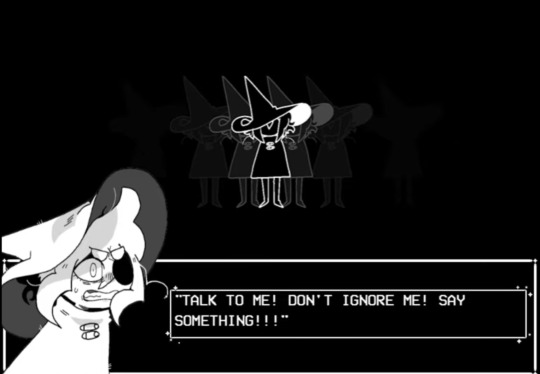
But he gets no response, as you get no attacks to strategize around. The wait for anything to happen is utterly agonizing. You and Siffrin are both waiting for something to happen. This isn't a fight. It just pretends to be. It's an utter rugpull, because Siffrin was so undefeatable for most of Act 4 and all of Act 5 so far. It's kind of terrifying!
and it does. It finally does something. Ma Du Pays speaks, in the voice of Siffrin's friends, listing out their deepest fears. I think it's honestly fantastic. You're forced to just sit here and listen to Siffrin's deepest doubts, things you know the characters could not say because it references the timeloops they're all utterly unaware of. This is all Siffrin, talking to himself. And all you, all Siffrin, can do, is keep wailing away on the enemy to no effect whatsoever.
So of course this ends with Siffrin giving up. What else can you do?
And then Siffrin's friends show up and unfreeze them and it's all very cool yay. The pure narrative scenes aren't really the main focus but I want to point out here:

A) Mirabelle is in the first party slot here, referencing how she's the de facto protagonist, and Bonnie fills in the fourth slot left empty, which shows all characters uniting to save Siffrin
B) this is the only instance of the other party members having act specific battle icons: they're all smiling brightly, further pushed by the upbeat music
C) the reflecting shield Mirabelle uses to freeze the King uses a variation of her hangout skill cut in, marking it as her true "final" skill and giving the whole fight a more climatic feeling.
It's also a short gameplay sequence with Siffrin utterly uninvolved in the battle. You can't even see them onscreen. But... it feels warm, doesn't it? Everybody coming together. Siffrin doesn't have to fight anymore.
At last, the King is defeated. Siffrin and co. make for the Head Housemaiden, to have her look at Siffrin's sudden illness. Siffrin is utterly exhausted, famished, running a fever. And this isn't unexpected - after all, their skills in Act 5 had no cooldown. For context, instead of featuring any sort of MP system, all skills work on a cooldown basis, where a character can't use it for a certain number of turns. The lowest cooldown is actually Siffrin's Knife to Meet You, which has a cooldown of 1. In universe, this is reasoned as the characters needing a break from spamming craft in order to not exhaust themselves.
Siffrin's skills in Act 5 having no cooldown/being infinitely spammable isn't a sign of their strength - it's a sign that he refuses to let himself rest in order to rush through as fast as possible.
Moving on, Siffrin panics when seeing the Head Housemaiden, because seeing her means one thing: the end. Prior to this in the game, every single time you beat the King, the loop ends when you talk to the Head Housemaiden.
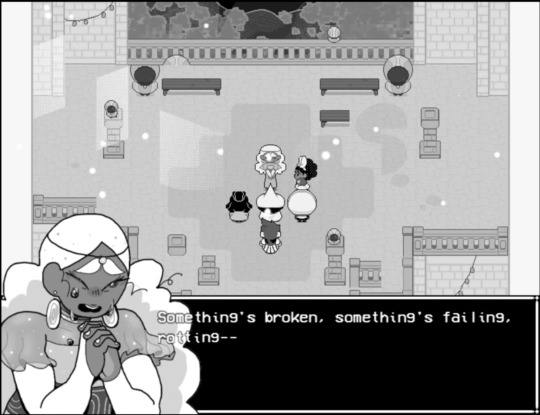
Reality breaks down, the whole shebang. It's here that Siffrin realizes - they don't want the loops to end, because the end of their journey means their family will leave, and he'll be alone again. The happiest time of his life will be over.
Siffrin goes totally ballistic, to say the least.
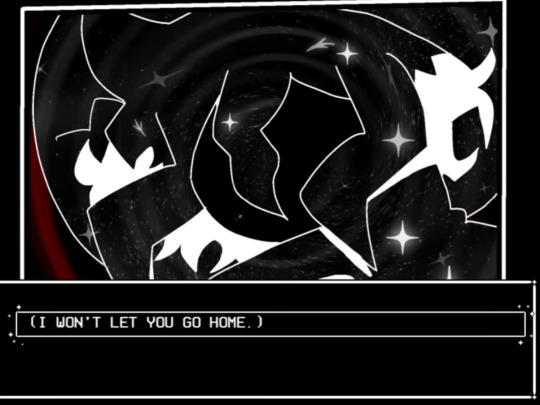
As it turns out (and was heavily foreshadowed narratively), Siffrin has been using Wish Craft to subconciously cause the timeloop because of their abandonment issues. It's rather predictable if you paid attention to literally anything, but it's extremely notable how heavily Siffrin is paralleled to the King, the antagonist they swore to kill by themself at the start of Act 5. The King wants to freeze Vaugarde in time because it is, in his mind, "perfect," for accepting him after he lost his home - a backstory he shares with Siffrin.
Siffrin has become the exact antagonist he swore to kill, and it's shown by how the next fight utterly flips everything on its head.
Siffrin is the final boss.

In a towering form made of stars, Siffrin looks down at their friends. His face is terrified, because of his internal conflict; he can't hurt his friends, but he can't let them go, either. The combat prompt is simply changed to "END IT!"
This fight is similar to the previous, in that you just need to wait a certain number of turns until its over. However, this time, it's not dreadful suspense. It's... confusion, and hesitance.
You have two options for combat: Attack your friends, or attack yourself.
And... you don't really want to do either, I think. I certainly don't. But what else can you do? It's Siffrin's desires clashing in full force. Attack your friends, and force them to stay? Or attack yourself, and let them go safely without you?
Worth noting, here - when you attack Siffrin's friends, you can't harm them. Isabeau will shield all attacks. And when you attack yourself, Mirabelle will heal you back to full. And the friends don't... do anything, either. How could they? Occasionally, Mirabelle heals you and Isabeau shouts words of motivation, but the main thing is...
(Your friends don't know what to do.)
None of them want to harm Siffrin. Both sides simply stare at each other, resolute in their conviction but unwilling to end it with violence. It's of note that this loop, the last one, is the only loop where the King isn't killed. Just frozen. And now here is Siffrin, clamoring for the same eternity the King was. Of course everything ends in a tearfilled conversation as Siffrin sees their friends won't leave him, even after the journey ends, but I still have to appreciate this moment.
Siffrin is directly put in the position with their friends as his enemies, forced to physically reckon that keeping them in this loop is an act of violence, against both their friends, and against himself.
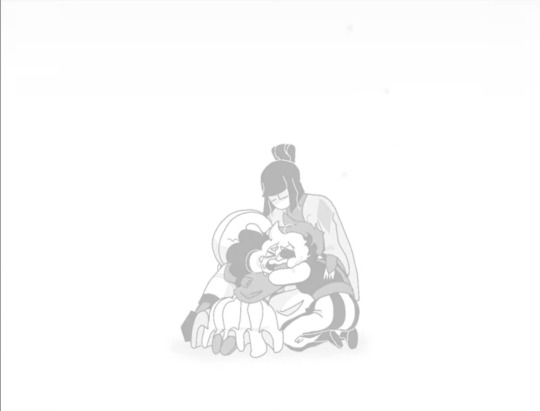
It's a happy ending. But... what does it mean?
Of course, ISAT is obviously about the fear of change. Siffrin is afraid of the journey ending, and of being alone. However, ISAT is also a game about games. Siffrin is playing the same game, over and over, because it's comforting. It's familiar. It's nice, to know exactly what happens next. These characters might just be predictable lines of dialogue, but... they feel like friends. Have you ever played a game, loved it, put countless hours into it, but you never finished it? Because you just couldn't bear to see it end? For the characters to leave your life, for there to be a void in your heart where the game used to be?
After all, maybe it became part of your routine! You play the game every day, slowly chipping away at it for weeks at a time. For me, I beat ISAT in four days. It utterly consumed me during this time. I had 36 hours of playtime by the end. Yeah, in that week, I did not do much more than play ISAT.
And once i beat it, i beat it, again. I restarted the game to see the few scenes I missed, most specifically the secret boss I won't talk about here. I... couldn't let go of the game yet. I wanted to see every scrap I could. I still do. I'm writing this, in part because I still do. It's scary to let go.
Ever heard the joke term of "Postgame Depression?" It's when you just beat a game, and you're suddenly sad. Maybe because the ending affected you emotionally and you need to process the feelings it invoked, or you search for something that can now fill your time with it gone.
The game ends, for real this time, the last time you talk to the Head Housemaiden. But Siffrin gets... scared. What if everything loops back again? And so, his family offers to hold his hand. They face the end, together.
For all loops, including the ending, you never see what happens after. After they leave the loop for good. Because the loop is the game itself. It's asking you to trust that life goes on for these characters, and it holds your hand as it asks you to let go. There's a reason for Siffrin's theater metaphors. He is the actor, and the director, asking everyone to do it over one more time. He's a character within the game, and its player.
There's a reason I talked about endgame content. This, the way it all repeats, there's nothing new, difficulty and stakes bleed away as you snap the game over your knee - it's my copy of White 2 with two hundred hours in it. It's me playing Fire Emblem Awakening in under 3 hours while skipping every cutscene. Are you playing for the sake of play, for the sake of indulging in your memories, because you're afraid of the hole it'll leave when you stop?
Of note: the narrative never condemns Siffrin for unwittingly causing their own suffering. He's a victim of circumstance. It's seen as endearing, even, that Siffrin loves their friends to the point of rather seeing the world destroyed than them gone. But Siffrin is also told: we'll stay with you for now, but we'll part ways eventually. And one day, you'll have to be okay with it.
Stop draining the things you love of every ounce of enjoyment just because you're afraid of what happens next. I'm not saying to never play your favorite games again. Playing ISAT a second time, I still had a lot of fun! I saw so many new things I didn't before, and I enjoyed myself immensely, reading the same dialogue over and over. But... it makes me look at other games I love and still play, and makes me ask... is this still fun? Do I still need to play this game to enjoy it? Even writing this is an afterimage of my enjoyment, but it's a new way to interact with the game, to analyze it through this lens. Fuck, man, I write fanfiction. Look at me.
All of this, fanart, fanfic, analysis, is a way to prolong that enjoyment without making yourself suffer for it. Without just going through the motions of enjoyment without actually experiencing any. But one day, the thing you love won't be fun to talk and write and draw about. And it's okay. You'll have new things to love. I promise.
In the end.... I'm certain I'll replay ISAT one day. Between great writing, art, puzzles and unresolved mysteries, it's my shoe-in for game of the year.
But I won't replay it for quite some time. I've had enough, for now, so I let my love take other forms.
Siffrin is never condemned, because love is no evil. Be it love for another person, or for a game. And please, if you're overempathetic - it's still a game, at the end of the day. The great thing about games is that you can always boot them up again, no matter how long its been.
A circle within a circle indeed.
To summarize:
The repetitiveness of ISAT's combat, lack of new enemies, and Siffrin's ever increasing strength eventually allows you to snap the combat over your knee, rendering it irrelevant and boring. Though this may seem counterproductive at first, it perfectly mirrors how Siffrin has also grown bored with these repeated encounters and views them only as an obstacle to get past. The reflection of Siffrin's own tiredness with the player's annoyance increases the compassion the player has for Siffrin as a character.
Additionally, the endgame state of the combat system serves as commentary on the state of a favorite game played too often, much like how Siffrin has unwittingly trapped themself in the loop. Despite the game having no more challenge or content left to over, a player might return to their favorite game anyway, solely to try and recreate the early experience of actually having fun with it. This ties into ISAT's metanarrative about the fear of change and refusal to let go of comfort even when the object (here, your favorite video game) offering that comfort has become utterly bereft of any substance to actually engage with. Playing for the sake of playing, with no actual investment to keep going besides your own memories.
Later on, stripping away even the pretense of strategy for a "press button and wait" format of final bosses highlights the lack of options at Siffrin's disposal and truly forces the player into their shoes. Truly, the only way to win is to stop playing.
#feli speaks#in stars and time#isat#isat spoilers#lays down on floor. it's done. it's done#i actually narrowed down in scope to just focus on the combat by the way. and this is like. several thousand words
1K notes
·
View notes
Text
Introducing Trilogy
Yesterday I released Trilogy, a new tabletop RPG crafted to support you in having grand adventures in worlds of your own making.
There are several reasons I started writing Trilogy, but the biggest one is that I ran a Dungeon World podcast called Crudely Drawn Swords for seven years and that was a lot of time to think about what we were playing. To a degree Trilogy is the game I wish that we could have had to run the podcast.
Starting from the question "what would a purely PbtA game for epic fantasy look like?" I started thinking more widely - what do I want from a fantasy game? And the truth is that I want a game that supports the structure of characters and their interactions but doesn't tie itself to a specific setting.
Trilogy begins with The Appendices - conventionally in epic fantasy these are at the end and document information about the wider world that might not have made it into the story, but here it is where you sit down as a group and decide what tone you want your game to have, and your world looks like. What kind of place is it? What magic is there? What is religion like? What are the major cultures where the story begins? How would it feel to be in this world? Trilogy doesn't tell you any of these things, it gives you the tools to think through how you want your world to look.
This creates a secondary challenge - without knowing what the world looks like, how could I design character classes for this type of game? Trilogy answers this by going back to the fundamentals - instead of a conventional character class, the playbooks in Trilogy represent a narrative arc. Some of them, like The Fighter, The Priest, or The Magus, look like familiar classes. Others, such as The Volunteer, The Mentor, The Weapon, or The Defeated, are a little different. Character arcs have a set of turning points, story beats that allow you to advance along your arc after you have collected a certain amount of experience. Some are positive and others negative, you choose which ones you want to hit and when, but every character's story has its highs and lows and to get the most from the game you need to lean into both. A character can pass through three arcs as they grow and change, like the three volumes of a trilogy.
The aim of the game is to create a slower but satisfying sense of progression - instead of hit points characters take Stress and Harm like in other Powered by the Apocalypse games that can have both mechanical and narrative effects. That makes combat feel dangerous, but the game also offers more ways to solve problems without getting into combat - I have played games where the player characters never got into a fight, instead resolving confrontations through an ingenious selection of alternative strategies including "lying" and "vomiting magic ink all over the floor."
I'm genuinely enthusiastic about this game - I think I would be as excited about it if somebody else had written it. It leans hard into the joy of discovery and the excitement of adventure - you can play it as spooky and whimsical or gritty and hard-edged and anywhere in between.
Because I was writing it I even got to make most of the examples of play roll out as the story of someone's game, something I always appreciate when I read it. It also contains every technique I use as a GM in the hope that even before people get the chance to play it (heaven forbid any TTRPG afficionado have books we haven't got around to playing yet!) people who read it will still be able to use that advice in their other games.
So that's Trilogy, the game I've been working on for the last few years. I think it's pretty great and I hope you will too:
Obviously it's a full-priced game and that's a big gamble from an unfamiliar creator - if you want an idea of what it's like in practice we've got the CDS team back together and we're starting a streamed campaign so you have a chance to see it in action. You can find that over on Youtube: https://www.youtube.com/watch?v=NxpXacko9Nc
The first episode includes me notably failing to use OBS at both the beginning and end, and I can't make any promises things will improve in that regard, but it should be a good opportunity to see how the game shapes up from this start and with this crew I know it's going to be funny and take some wild swings.
If you're interested in reviewing Trilogy or you really want to give it a try but you can't afford it, drop me a message
118 notes
·
View notes
Text
Alright, let’s start with discourse, shall we?
Gatekeeping Combat
Three days ago, the Gorgon Bones blog made this post about fighters in TTRPGs (particularly the OSR): https://gorgonbones.blogspot.com/2024/02/choosing-fighter-means-choosing-violence.html?m=1
I recommend reading the post, it’s fun (and the comments are hilarious). But, for those who don’t have the time or attention span (trust me, I’m lacking in spoons right now too), this is a relatively short joke that suggests protecting the Fighter class’ niche by making it the only class able to participate in combat. This, on its face, seems like an inherently silly idea—because it is—but people have been interacting with it as a serious suggestion. This comedic concept has spawned a legitimately interesting design discussion. So, let’s engage with it as a thought experiment. How would one make this function in a fun and reasonable way? The simple answer is that you have to start with conflict.
Conflict in RPGs, particularly in Dragon Game derivatives (such as the OSR), is often violent in nature. This presents the first hurdle: How do we centralize combat to 1 class when it’s a major source of conflict, conflict that people inherently want to engage in? As I see it, there are two approaches:
Decentralize Combat.
Redefine “Engaging in Combat.”
Decentralizing combat is kinda just what it says on the tin; make combat a less important source of conflict and means of resolving it. The two biggest examples of this—to me—are Investigative Horror Games and Stealth Games, both of which rely on central conceits that CAN involve violence but don’t necessarily rely upon it. A non-OSR example would be John Harper’s Blades in The Dark, in which combat is resolved the exact same way as every other conflict: through a series of dice rolls that result in ticking and unticking a clock (with possible complications).
Redefining what it means to “engage” requires a bit more definition than the prior approach. “Redefining” can be subcategorized into two somewhat disparate techniques: Redefining goals and redefining interactions.
In any TTRPG combat, the party tends to have a list of goals that exist in a hierarchy of priority. For example, in a traditional D&D or Lancer combat the hierarchy of party goals might look like this:
The Contest (express martial superiority, wipe out the opposition, or otherwise win the combat)
The End State (survive the combat and prevent as much harm to yourself or other party members as possible)
The Barrier (achieve the exploration or narrative goal that’s being hindered or prevented by the combat)
“Redefining” these goals is more accurately described as a re-ordering of their hierarchy based upon whether you are or aren’t the Fighter, usually through gameplay incentives. An incredible example exists in the form of Mike Pondsmith’s Cyberpunk 2020, in which the Solo role (through virtue of acting first and being generally able to specialize heavily into combat) can almost singlehandedly decide the outcome of any fight in which they are present. If there is one Solo on the field, their side is probably going to receive a swift victory; your job, as the non-Solo, is simply to not die and accomplish what you actually came here to do. If there are two Solos on opposing sides of the combat, their goals change to winning their private fight; your job, as the non-Solo, is to survive the surrounding combat until the Solo is free again (or to run if they lose). In almost every combat, the Solo will prioritize the Contest while the rest of the party will prioritize either the End State or the Barrier, something aided by Cyberpunk’s lethality and its nature as a heist game.
“Redefining combat interaction” is . . . actually found everywhere. This is your basic class differentiation taken to a greater extreme than you may find in most tactical RPGs. For example, let’s look at the Combat relevant difference between the Thief/Rogue/Mercenary and the Fighter in a majority of games that use such classes:
The Fighter - Deals a lot of damage with consistently accurate attacks (sometimes also makes multiple attacks on their turn). Has high health.
The Thief - Deals a lot of damage with one really powerful attack made from stealth, sneaky (sometimes good at dodging). Has low health.
The differentiation is there, but it’s not really significant (for the purposes of this thought experiment). Both classes focus on damage output, but one makes multiple attacks and one makes a strong attack that requires setup. Let’s try to take this difference and expand it (with a little help from our dear friend Tolkien), particularly by focusing on what makes the Thief unique in comparison to the Fighter:
The Fighter - Deals a lot of damage with consistently accurate attacks (sometimes also makes multiple attacks on their turn). Has high health.
The Thief - Subverts direct combat through the use of trickery and cunning, plays support for the Fighter (sometimes good at dodging). Has low health.
“Subversion,” in this context, simply means fighting dirty. The Thief shouldn’t be engaging in a head-on fight, they’re a Thief. Their interaction with hostile entities should always be tinged by deceit, their goal should always be to throw their enemy off balance, to create openings for others and themselves to use. If your Thief isn’t constantly throwing pocket sand and disarming opponents and knocking chandeliers on top of them and pulling cloaks over their eyes and poisoning them and . . . are they really living out the Thief fantasy? By strengthening the Thief’s core identity, leaning fully into the trickster aspect, we have redefined how both classes interact with Combat in such a way that has made direct, head-on-head violence the apparent specialty of the Fighter.
Conclusion
As much as the original Gorgon Bones blog post is a joke, Jenx does point out a real issue that’s plagued class-based games for a while: a weak niche makes a weak class. Not necessarily mechanically weak (although that can also happen, looking at you CP2020 Cop), but weak in the sense of fundamental design. Strong niches, even if every class has the ability to participate in combat, are born of purposefully and carefully built interactions with the conflicts presented by a game’s rules and environment. If combat is too great of a focus, everyone is going to want to be able to play the guy who’s good at combat; if winning combat is the sole goal of any given encounter, everyone’s going to play the guy that’s good at winning combats; if every class gets good tools for dealing damage . . . well, I don’t really have to spell that one out, do I?
If you’re designing a tactical, class based game: don’t make the Fighter the only class able to engage in combats. It’s lazy, it’s silly, and it won’t be fun for very long. You may notice that, while the two games mentioned here have classes that EXCEL at direct combat, neither of them fully limit it. Instead, the proper lesson of this thought experiment is a far more common one in our field: keep in mind the incentives you’re building into both your game and your classes, and be aware of how all these moving parts interact with and affect each other. After all, the Solo wouldn’t be nearly as good if Cyberpunk wasn’t so lethal, and the Cutter would be far more ubiquitous if Blades in The Dark had a dedicated combat chapter.
Self Promo
Hey! Thanks for reading. Sorry to leave ya with Baby’s First Game Design Lesson, but I hope ya enjoyed the journey there. If you’d like to see my recent attempt at a class based fantasy game, you can click here to check out Hollow Halls. Otherwise, I hope y’all have a great night and a great day!
136 notes
·
View notes
Text
Character Spotlight: Shear
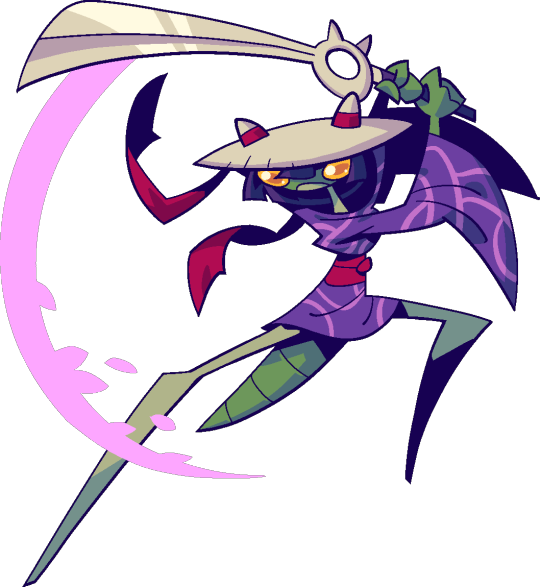
Shear, the Wind that Cuts, is a Reiken'O, a tribe of mantis-like creatures living deep in the Frostfang Mountains. The Reiken'O lead an austere existence, following a strict set of laws laid out centuries ago by their ancestor, Hurricane, the Wind of Destruction.

The game begins with Shear on the eve of her own ritualistic suicide. Since her mating ritual bore no fruit, she has upset the balance between life and death. However, she sees visions of the headless corpse of her Eternal Mate, pointing to the village's exit.
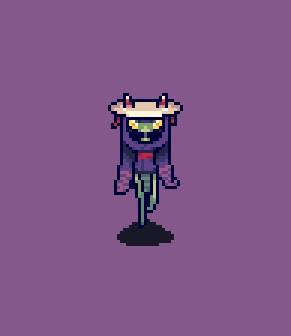
Shear leaves her village in order to find meaning in a world of death and to shatter the chains of tradition her people have shacked her with. However, the Reiken'O must reclaim the balance of life and death. They will not let her go easy.

In combat, while Shear has the use of some magic of the mountains, she is mainly a physical attacker, quickly and efficiently dispatching her foes with her blade, Ice Dragon Nail.
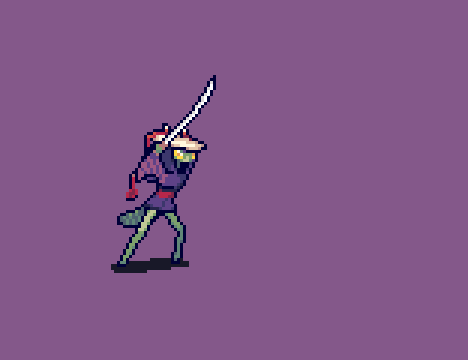
Since she's a trained Reiken'O blademaster, if Shear uses her techniques in a specific order, they will gain new, devastating properties. She's an expert warrior who does well in normal encounters and becomes an absolute monster in a prolonged encounter.
Want to experience Shear's story? Support Hymn to the Earless God on Kickstarter!
218 notes
·
View notes
Note
I just wanted to let you know that I just found your tumblr within the past week and you have immediately become my 2nd favorite tumblr, being only behind Blogatog. Love your ttrpg takes.
Anywho, you said to ask about flags, so what is your biggest/are your biggest red flags when it comes to ttrpg design?
thank you! i'm glad you enjoy my silly little posts. anyways i think my biggest red flag is unintentionality--the feeling that the writer of a TTRPG has done something by 'default', the inability to put myself in their shoes and understand (or even better, be told by the text itself) the reason why a particular decision has been made.
one of the biggest places this rears its head is in terms of tone and voice. let me quote jay dragon's really good the storyteller technique:
Another advantage of getting to know the narrator of your RPG is that it helps mitigate unconscious bias in your design. Dungeons & Dragons has a notably anthropological narrative voice, explaining other cultures and creatures like a scientist in the field. The language of D&D mimics the writing style of mid-century scientists traveling to “exotic” locations and cataloging non-Western experiences as part of a documentation of the Other. It’s easy for newer designers to want to “write a game like D&D” without regard for how even the narrative voice of Dungeons & Dragons carries unintended political baggage. Is a bird’s-eye and judgemental perspective really the energy you want to bring to your whimsical fantasy world? Or is there another perspective within your world that can be more useful, and allow you to find new perspectives on the world you’ve created.
narrative tone is a choice--the attempt to use a 'neutral' tone for rules text and description is also a choice, how formal and how informal you get with it is a choice, and when i read a text that seems to have made that choice thoughtlessly it imo bodes very poorly for the rest of the game.
other examples of this kind of unintentionality are games that have a comabt system despite not being about combat in any way--games with equipment rules despite them not setting out to tell the sort of story where which sword or gun a character has matters--games that measure themselves in exact distances without actually using a battlemap--&c.
while most of this unintentionality takes the form of 'falling back onto what DND does' because DND is the market leader and many people's first TTRPG, so imitating it without purpose is something that both cynical market-share chasers & unexperienced designers without a wide range of expereicne can do--it's absolutely not unique to it. one form of unintentionality i see a lot in indie TTRPG circles is creating far more Moves for your PBtA game than necessary--clearly more out of a sense that 'AW/MotW/Masks has a Move for this' than any specific understanding of what that move will do in your game
in game design--as in any art--there is no such thing as a 'neutral' choice or a non-choice. there are only choices, and how much someone's thought about these choices is important!
358 notes
·
View notes
Note
Hi! This request was easier to search for, so I see you’ve recommended Hearts of Wulin and Ten Thousand Days for the Sword. Do you have any other wuxia or xianxia game recs?
Have a good day!
THEME: Wuxia Games.
Hello friend, I'm certainly not an expert, but after reaching out to some more knowledgeable folks, I think I have a few!
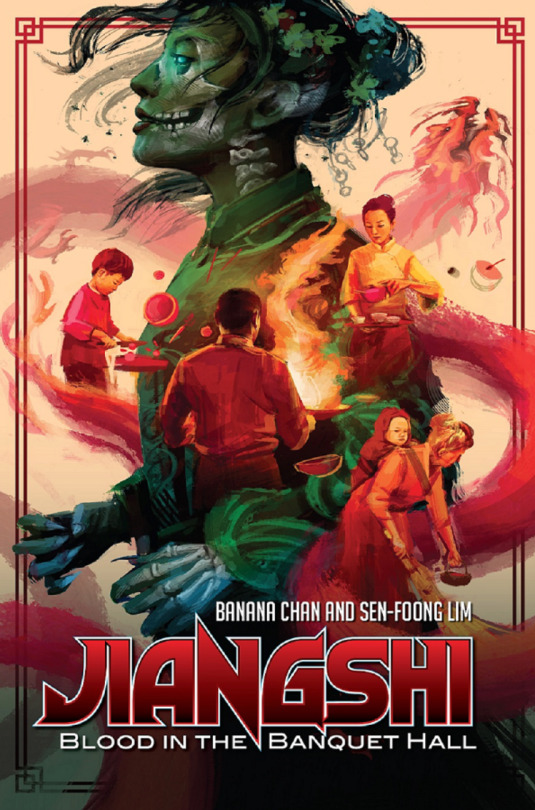

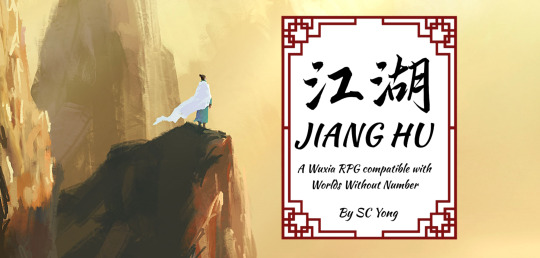



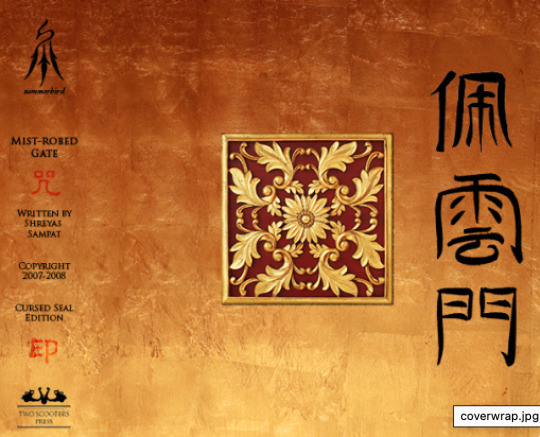
Jiangshi: Blood in the Banquet Hall, by Wet Ink Games.
This is a collaborative, storytelling RPG about a Chinese family making their living by running a restaurant in one of America’s Chinatowns, circa 1920. Despite societal backlash and anti-Chinese laws, they have turned a profit and their quality of life has recently improved.
Night, however, brings a new terror.
Players take on the roles of members of the Chinese family (mostly from Guangdong province), spanning three generations, who face threats of jiangshi (hopping vampires) at night and racism by day. It has players balancing the responsibility of maintaining their family business with protecting themselves and their community from the dreaded Jiangshi. This is primarily a game about storytelling. Combat is limited, but horror, drama and sometimes comedy are the primary vehicles for driving the game forward.
This game draws quite a bit from boardgaming elements, so I think this one is best played around a physical table, especially since it requires a custom deck of cards. You’ll use these cards to represent the demands of running a restaurant in the day, as well as fighting of a vampire at night. This game is probably on the borders of what I think is considered wuxia, but if you have a horror lover in your group, this might be worth checking out.
Exalted, by Onyx Path Games.
This is the tale of a forgotten age before the seas were bent, when the world was flat and floated atop a sea of chaos. This is the tale of a decadent empire raised up on the bones of the fallen Golden Age, whose splendor it faintly echoed but could not match. This is a tale of primal frontiers, of the restless dead, of jeweled cities ruled openly by spirits in defiance of Heaven’s law. This is a tale of glorious heroes blessed by the gods, and of their passions and the wars they waged in the final era of legends.
Exalted has a number of different sources, only one of which feels close to wuxia, but the stories are certainly expected to give you long, sweeping epics and larger-than-life characters. There are many different kinds of Exalted, including Solars, Lunars, and Dragon-Blooded. Since I’m not a wuxia connoisseur myself, I’m not entirely sure how close Exalted comes to hitting the mark - I’m mostly recommending it because it came up connected to some other wuxia fantasy games when I was doing some searching.
Jiang Hu, by wum1ng.
Jiang Hu is a role-playing game for the wuxia genre. Drawing inspiration from wuxia novels written by luminaries such as Jin Yong and Gu Long, the Feng Yun comics from Ma Rong Chen and the multitude of wuxia movies and television series, this game brings the world of dashing swordsmen, warrior monks, brawling beggars and high-flying stunts to your tabletop.
Players take on the role of Martial Artists fighting against various threats to the lands of Jiang Hu, ranging from evil sect leaders who have mastered forbidden secret martial arts techniques to megalomaniacs seeking to take over the Imperial Throne by force and the blood of countless innocents.
The Worlds Without Number series by Kevin Crawford has its praises sung by many people, especially folks in the OSR scene, and that is the bones that this game is built on. Your character is built from quite a list of skills, which are differentiated between Combat and Non-Combat. You also have a number of secondary attributes, for things such as Armour Class, Evasion, and Luck, as well as a dedicated space on your character sheet for weapons and martial arts. Expect combat to to take up a bulk of your time!
When you roll for your character background, you also get a significant life event that is expected to shape your character’s past, such as having a loved one murdered, or falling into serious debt. Out of all of the games listed here, I think this game is the closest to D&D, what with the “packages” of skills, items and abilities attached to each background.
The Oath, by brushmen.
"We seek not to be born on the same day, but hope to die on the same day." And with such an oath, Yong, Li, and Ming swore loyalty to each other.
When earthly desires tempt them, and devotions threaten to tear them apart, with or without a hand from uncaring fate…
will their oath endure?
The Oath is a collaborative storytelling game for one Game Moderator and three players.
This is meant to be a one-shot, which borrows the Entanglements system from Hearts of Wulin and the character Keys and Tags from Lady Blackbird. Since this game comes with characters already pre-written, it would probably be very good for groups who have very little time, or who want an easy on-ramp to games or the wuxia genre. I like the fact that the Keys give you prompts and directions for your character’s behaviour; it’s strong statement on how the author interprets the genre, but it still gives you, the player, a choice on what elements of your character will be emphasized, and what elements will take up the background.
brushmen also has another wuxia Lady Blackbird hack called The Escort, about recovering from a violent robbery, this one for four players and one GM.
Four Swords, by ehronlime.
This is a tabletop roleplaying game about being young heroes in a wuxia story, made for the #AsianMartialArtsJam.
You start with your First Sword, which you use to challenge other heroes and villains and strive for mastery.
You will then gain three more Swords: the Second a sword of great pride and regret, the Third a sword of mastery and expression, and the Fourth a sword which is no sword.
You will also struggle between the obligations put upon your by others and what you truly desire from the life of a wandering hero.
Four Swords really zeroes in on the combat mastery part of wuxia fantasy. Your characters will grow into mastery, and battle with rigid codes and rules that structure the world you live in. The game is very descriptive, leaving you with only 4 abilities that are meant to broadly encompass what you are able to do. The game encourages characters to interfere with each-other using a mechanic called Vows, and levelling up gives you access to different techniques, which reinforce the competence of your characters as well as the rigid guidelines by which they might improve.
This game was made for the Asian Martial Arts by Asian Creators Game Jam, so you might find some more wuxi-themed games there!
Blades of the Immortals, by Jagganoth.
Blades of the Immortals is a tabletop roleplaying game inspired by xiānxiá. It uses the Forged in the Dark rules engine developed by John Harper, as seen in games like Blades in the Dark and Beam Saber.
In Blades of the Immortals, you will take on the roles of cultivators, striving for your own ambitions, for the glory of your sect, and for the ultimate prize — immortality. You'll viciously struggle for scarce resources, compete for the patronage of powerful and influential teachers, gather allies to your banner, and scheme against your enemies. Your cultivators will wield mystical treasures and supernatural spell-arts, mastering the very laws of the cosmos as their weapons, as they become entangled in centuries-long vendettas between deathless wizard-kings.
This game is solidly focused on supernatural abilities and grand increases in strength. You choose from one of 9 different playbooks, and collaboratively create a faction that binds you all together. The sources listed as inspirations for this game include (but are not limited to) Grandmaster of Demonic Cultivation, Forge of Destiny, Aspiring to the Immortal Path, and Journey to the West.
Compared to other Blades hacks, this game reduces the standard number of action ratings, ties character growth to a change in your character’s beliefs, and separates your gear from your playbook. Characters can also level up through Realms, which increases your effectiveness and upgrades your inventory.
Mist-Robed Gate, by Shreyas & Elizabeth Sampat.
There are some things that we value more than life.
There are things we're willing to scheme and cry and fight and die for.
That's what wuxia cinema is about— fighting and dying for the things we care about. That's what Mist-Robed Gate is about.
Mist-Robed Gate comes with a full list of movie recommendations, but includes Crouching Tiger, Hidden Dragon and House of Flying Daggers as key influences. I really like the fact that a key mechanic of this game includes stabbing your character sheet with a knife.
Players create factions first, and then take turns creating characters that represent those factions, with elements that represent the hero’s distinctive personality and style. Players also create the different locations that will serve as the stage for your scenes. Play happens over a series of scenes, as their characters push and pull against each-other, sometimes even making terrible demands (which is where the Knife comes in). If you want a game that has a lot of politics in the terms of actions having large ramifications over big groups of people, and if you want a game that is extremely dramatic, you might want to check out Mist-Robed Gate.
47 notes
·
View notes
Text
The First Blade: Balaraw - Winged Dagger
I realize I haven't been explicit about it on here yet (mostly because I'm not the best at keeping all my social media profiles up to date), but I am involved in the development of a Tabletop Roleplaying Game
It's called Gubat Banwa- a TTRPG based around tactical grid combat, contemplative war drama, and high-flying martial arts, all of which taking place in an unapologetically Southeast Asian-inspired fantasy setting, developed by @makapatag with art direction by @villain-returns.
Initially I developed the script that is used in the gamebook and diegetically in the setting- called Kasuratan- but I'll talk about that elsewhere.
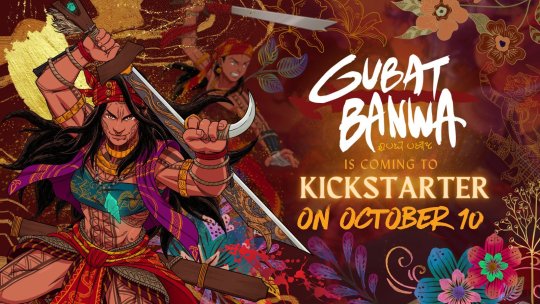
With the Kickstarter launch imminent, I thought I'd do a bunch of Twitter X threads on a bunch of weapons I've drawn for the game counting down the final week before the launch. Then I thought: "Why aren't I posting these on tumblr also, at least I wouldn't lose my mind over character counts over here"- so here we are. These were supposed to be posted as Swordtember drawings, but then the KS launch got moved to October.
Most of these blades are of Philippine make, since that is where my knowledge-base is and what I'm comfortable enough to share knowledge about. I thought it'd be nice to share a bit of blade knowledge from some of the cultures that inspired the setting.
Without further ado, let us begin with the BALARAW.
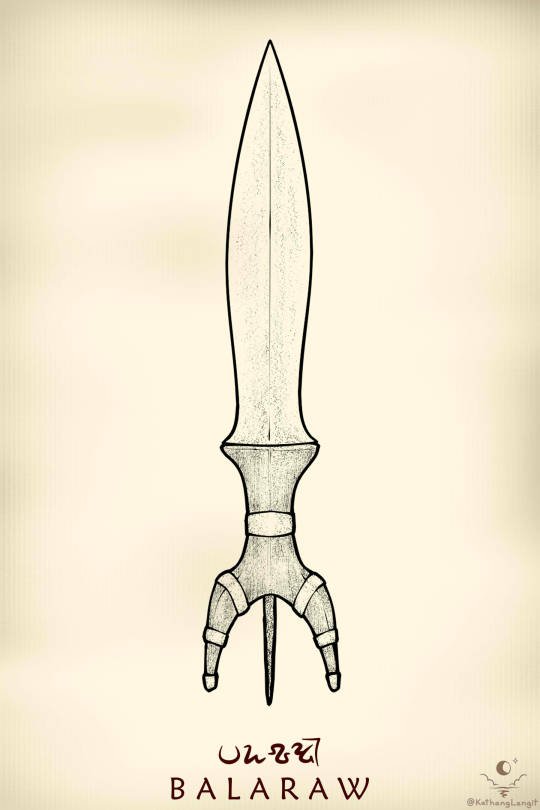
Also known as a "winged dagger", it is characterized by its unique shape, consisting of a short leaf-shaped blade driven with the tang out into a hilt with two distinct protrusions, creating three prongs on the back with the tang included.

(Photos from an exhibit at The Met)
They may be held at the hilt like a regular knife, or they may be held in a manner not too dissimilar from how our neighbors in Southeast Asia hold keris. One may imagine it like a "push dagger" for lack of other reference points. It might be likened to the katar as well, in some sense.


(Sketches by the Gubat Banwa Art Director himself)
Nowadays, the blade is frequently attributed to the People of the Upstream- the Mandaya group of peoples- though they would have seen much wider use in their day, likely also spanning across what is now the Visayas region of the Philippines.

(Modern rendition by Panday Keiven Tolentino of Itak Mindoro, Photo by Ramon H. Bathan)
Something I've noticed from looking at Philippine blades all the time is that symmetrical, double-edged blades like these are rare, here. Blades that lend themselves more to stabbing than anything else aren't very prevalent either, and blades that do not- at first glance- appear to be made with tool use/foliage clearing/farmwork in mind don't make up the majority of specimens.
The balaraw is unique in several different respects, and any self-respecting warrior Kadungganan of Gubat Banwa's Sword Isles would do well to mind its bite.
The weapon makes an appearance in Gubat Banwa in the hands of the Beast Hunter- one of the many Disciplines ("character classes") whose techniques your character can learn in-game.
The Gubat Banwa Kickstarter launches in 7 days! Check it out here:
We'd appreciate any and all help in getting the word out. Support an independent TTRPG made by a team from the global south, looking to make waves through a fantasy setting where the Southeast Asian inspirations takes center stage!
#gubat banwa#gamedev#ttrpg#ttrpgs#indie ttrpg#indie ttrpgs#tabletop rpgs#rpgs#rpg#southeast asia#southeastasia#dnd#kickstarter#swords#philippine blade#weapon design#dagger#balaraw#philippine history#philippine culture#filipino artists#artists on tumblr#kathang langit#help us get the word out!#fantasy#fantasy worldbuilding#swordtember
113 notes
·
View notes
Photo


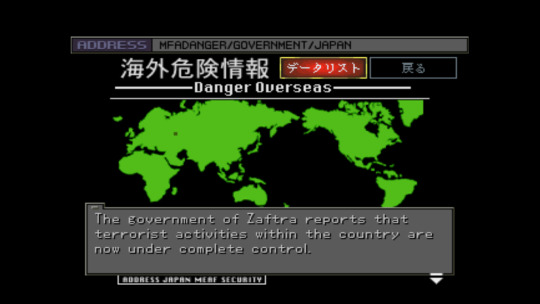
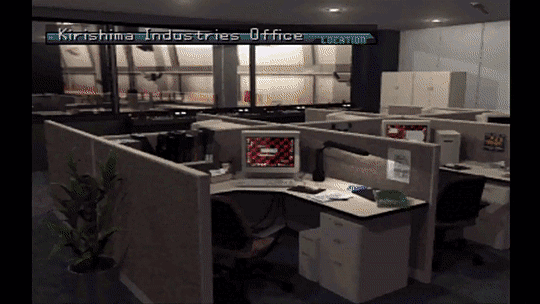


- Lessons in Japanese Game Design #3 -
Aside from what is easily one of the most stylish presentations in a videogame from the 1990s, one of Front Mission 3′s truly remarkable features consists of an in-game internet browser running within a simulated operating system. Expanding on the concept first rehearsed by Squaresoft in the second entry of the series, this massive component of the game can be accessed during breaks between missions, offering the player access to a number of pages for government entities, enterprises or other institutions. Access to additional websites is permitted as the game progresses.
This inventive solution offers unparalleled insight into the fictional universe of the game, in that it paints a very granular image of a futuristic society, its economy, geopolitical environment and zeitgeist. The information contained in these pages comes in the form of of bulletin boards, institutional updates, press releases, top secret data volumes, or the occasionally amusing curiosity. The user interface itself permits some degree of customisation, such as the option to disable the startup animation - itself a gorgeous visual relic that one hardly tires of watching - or changing the wallpaper pattern. Certain websites will also provide the option to download content, including images which can be set as said wallpaper. Other resources require secure access via the insertion of a password. Moreover, the player will have access to an email inbox to both read and send messages as may be relevant to advance onto the next stage.
Make-believe computer front-ends in video games were no novelty by the year 1999. Several sci-fi adventure, role-playing or action games allowed access to often very believable GUIs for the purpose of, for instance, retrieving precious clues or, say, disabling security locks. Aside from Front Mission 2, Final Fantasy VIII fans will likely remember the exciting Balamb Garden Network terminal. Kowloon's Gate's unforgettable Kownloonet terminals gave access to an email inbox, an all-important database and various other quotidian curiosities that helped fleshing out its mystic sci-fi narrative. The Japanese were privileged to have a complete version of Ace Combat 3: Electrosphere with access to an in-game encyclopedia the player could browse, as well as additional story elements told through email exchanges between the characters.
That same year, the western Tactical RPG sensation from the West, Jagged Alliance 2, dabbled in this idea. Only three short years later, CyberConnect2′s singular .hack series was designed around the idea of a MMORPG that plays offline, allowing for countless interactions with non-playable characters which simulate messaging formats of the era. Other notable examples include the 2chan boards in Steins;Gate or, inescapably, the passionate love letter to web 1.0 that is Hypnospace Outlaw.
Generally, all of the aforementioned titles are either entirely dedicated on a similar concept, or merely resorted to it as a secondary, amusing distraction. Front Mission 3 pioneered the use of this device as a storytelling technique. No other game of the time, at least to my knowledge, had dedicated so much of its resources to producing a credible replica of design and functionality of the internet as it once existed.
#front mission 3#squaresoft#the internet#lessons in japanese game design#storytelling#operating systems within games#internet within games
159 notes
·
View notes
Text
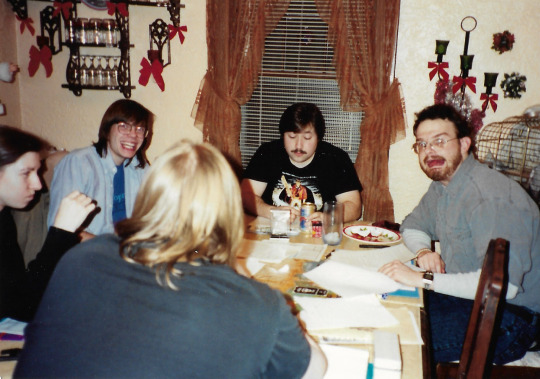
Don't Roll: Great RPG Mechanics
#RPGMechanics Week Ten (finale)
(author circa 1990 pictured with tie)
This is maybe more a technique than a mechanic, but it represented a significant change in approach and play for me over the years. This has two components– the first is “don’t roll if it isn’t important.” I know this sounds simple, but it wasn’t always the approach in systems and play.
Like many others, I started with D&D, but very quickly I moved into other games. A large swath of games added on to D&D/AD&D’s approach by including skill systems. They usually had the same emphasis on combat, but included mechanics for handling other kinds of tasks with a discrete roll rather than a saving throw or attribute test. So we had the chain which came out of Traveller and Basic Roleplaying which spawned my early favs like Fringeworthy, Top Secret, Champions, Rolemaster, and GURPS.
You needed a skill to try something, with the unskilled being given arbitrary big failures by the GM when they made their attempt. Players had invested in their skill choices, spending precious points and advances, so they needed to roll those checks regardless of circumstance. So you got rolls for the dumbest, small things– with the action grinding to a halt for plot crucial roles or moving to escalating violence for other things (like a failed social roll).
Basically if there was a task and the game had a skill related to that task, you always rolled for it. Some games, like GURPS, recognized a sliding scale of circumstance with a host of modifier tables which could be applied to tests. Usually those got forgotten in play. While we had some handwaving, we rolled a lot of tests. I saw this in my local play groups and at gaming conventions large and small.
I don’t know which game explicitly said don’t make a test unless it matters, but it shifted our play. It moved skill tests from being gotcha moments and “roll til you die” sequences. We were young and stupid– raised by a generation of punishing GMs who delighted in catching players out when they hadn’t selected the right skill during character creation.
F*ck the good old days of roleplaying. I wouldn’t go back to the play culture of the 80s or 90s for anything.
In any case, over time the game advice not to roll for every damn thing took hold. Low difficulty tasks could be assumed to have been handled successfully; more room emerged for play. Of course everyone still rolled perception checks, which remained the last refuge of gotcha gamemasters.
Which brings us to a refinement: “don’t roll if failure isn’t interesting.” At first this sounds like pretty much the same thing, but there’s an important distinction. Instead of judging whether it affects the plot or moves the story, we’re looking more seriously at the context of the action. What does a failure here look like? What would make that moment have weight and stakes? We begin to consider what kinds of pressures can be there: use of resources, race against time, alerting the opposition, starting a countdown.
So when a GM calls for a roll, they’re implicitly saying that failure will have some consequences– things will happen. It’s pushing them to make clear to the player that there’s a potential cost. Both the GM and the player have to think about the circumstances now. Which means generally that we’re more likely to cut to the action and have dice rolling moments outside of combat actually add to the game.
It’s a short step from that concept to Fail Forward, to Success at a Cost, and to player-driven or collaborative choices for costs. It changes the nature of the game– and I think it changes the relationship between the GM and player. That relationship might still be adversarial, but the GM has to back that up by making gotcha moments worthwhile.
I’m not sure when and how this new play praxis developed– it probably isn’t the result of a single game. I know over time I handwaved more and more– and eventually felt justified in that when I saw it explicitly mentioned in the game rules. There’s been an invisible evolution of play culture over the decades and that’s been generally for the greater good.
Here’s the thing: I know how stupid this sounds. I know how obvious this appears these days. I thought back to consider if this was just something in my game group at the time. But it was across the dozen different groups I played with and there at every game con I went to (Gen Con, Origins, Michicon, Griffcon, etc.). I can recall sessions where the pressure of rolls added to the tension and drama, but I remember more sessions where the constant rolling wore things down.
46 notes
·
View notes
Text

Forgive me a moment of kahilas, but let me tell you why you'd want to play Gubat Banwa for your next Tabletop RPG Fantasy campaign (or kandu, as we call it!) instead of the other prospects out there! Long post ahead~

1: You want a fantasy setting that doesn't have a foundation in modern and western paradigms. This one is the easiest one to pitch. This is not just for those that are tired of European Medieval Fantasy: this is for those that want to look at the fantasy genre through new lens
It's one that doesn't have "adventurers" as an inherent fact of the setting. It doesn't accept "defaults". It doesn't romanticize monarchism. It is built from the ground up for tactical fights and the complicated contexts that surrounds those fights. "Combat as storytelling"
It centers us, in the Southeast Asia. So there are some things that might not be as common as in the West:
- oversea and river travel is much more common (and let's be honest, easier) than pure overland travel.
- Honor and Debt are huge parts of the game's social systems (and if you do some reading on medieval societies, aren't even unique to Southeast Asia at all!)
- There's no single dominating culture or empire: it's very diverse, and we don't use any one culture as the default
- You can adapt any Fantasy style campaign you have really, though it is a paradigmatic shift! You'll have to let go of fantasy defaults and imagine a wilder and more vibrant world
- There are no elves or orcs or whatnot--for us those are chaining things, binding things. Gubat Banwa is the wind. In fact, the closest thing we have to "humans" are strange bamboo people - Anything in normal fantasy has a fresh take: Knights wear moonstone armor and ride upon omen bird steeds, "berserkers" are holy martyrs ready to die for Goddess, sorcerers are mantra and mudra masters and utterers who have an enlightened will sharpened into a blade, archers are zen-daoists who have suffused into their surroundings and achieved minor enlightenment
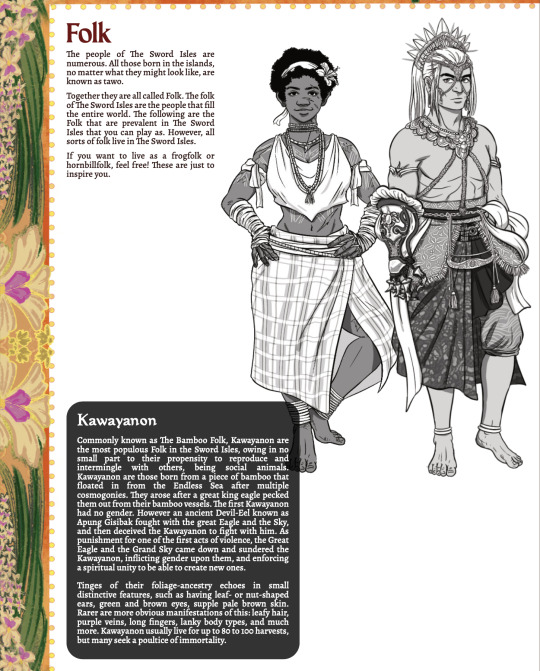

2: You want a game that's specifically built around war drama and martial arts combat and the kinds of stories that entails. There's a section in the book that covers "What kinds of stories you can tell" with the GB System
These genres are the kinds of stories i love to partake in and consume: stories of wandering martial heroes, or of complicated political warring, or of grand gods and sorceries a la Ramayana, or of small stories of warriors protecting their community
dungeon delving is not even inherently against the feel of this game, though of course sacking a grave is looked down upon by most religions in the isles. they are functionally replaced by "Raids" which is much more widely applicable! You can even Raid Heaven and Hell!


3: You like complex buildcrafting, tactical combat, and martial art fiction. Instead of the classic "Hey we're a bunch of scrappy mercenaries that wield a sword out of necessity", you play as Kadungganan who inflict violence by choice, philosophy and will
"Martial Arts" here is every kind of way of inflicting violence, or of perfecting one's self. Elementalist sorcery? Combat healing? Pugilism? Mantra utterances? All martial arts in Gubat Banwa's purview.
This feeds into the buildcrafting: you start with a "Discipline" (a martial art), and each Discipline has a number of Techniques within it. Whenever your Legend Grows (level up) you gain 2 Techniques from ANY DISCIPLINE, keeping in mind prerequisites
This has led to some genuinely flavorful builds: like a priest from beyond the dead crocodile rider, a sniper that launches stolen demon seeds, a folk healer who practices flower necromancy and swordmancy, and even a Knight-Monk that is constantly dancing between stances


All of this is built upon a tactical combat system that (similarly to PF2e!) has three actions as a base, and you can do anything with those three "Beats", lending to the martial arts fiction being invoked
And you start off with pretty limited options, so most of your build is pretty emergent: creating a Kadungganan is easy, since you can't choose from a huge pool of options, but advancement is exponential
It's all on a tactical grid too that has important considerations such as Elevation, Terrain, and even Weather! All to create slick wuxia-esque scenes!


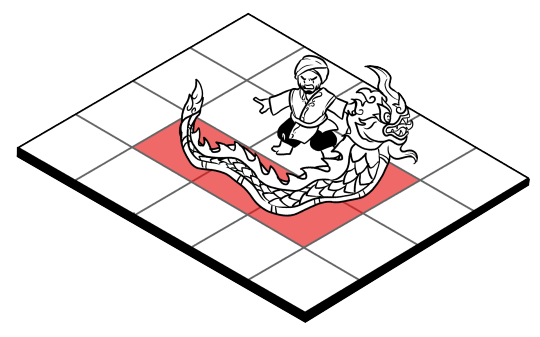

4: You want an endlessly iterative setting. Gubat Banwa is a trichiliocosm, which means it has three-billion worlds. Each one might have your table's version of the Sword Isles. The Sword Isles is a gigantic archipelago, too many islands too count, too many kingdoms to track.
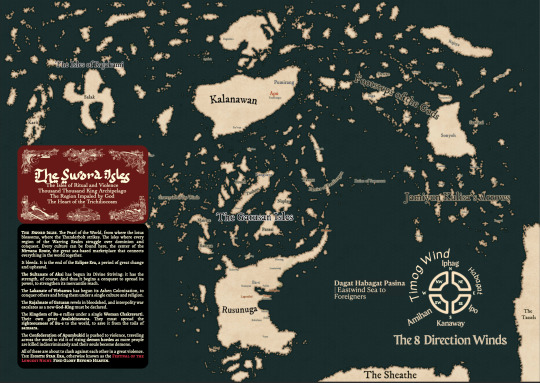
Everything you can think of will fit into the islands of the Sword Isles, just know that it centers Southeast Asian paradigms. A wandering adventurer from a far off land will be the exception, the norm. But endlessly interesting cultures and campaigns can arise from the Isles
And so much more. If you're already interested, take a gander at our itch page:
Also we have a discord where i run games back to back like a goblin: https://discord.gg/8h7ZrU6353
#gubat banwa#ttrpgs#rpg#dnd#d&d#tabletop#fantasy#ttrpg#please try our game out please we're facing big giants in this industry with this game
147 notes
·
View notes
Text
How to use Martial Arts in your TTRPG
Elevate your tabletop RPG battles with martial arts techniques! 🌟 Our latest video shows you how to integrate thrilling combat moves into your game sessions. 🎲Ready to level up?
#RPGCombat #TabletopGaming
Ninjas & Superspies
Embrace the path of the warrior with our comprehensive guide on integrating martial arts into your tabletop RPG. This video illuminates the seamless ways to weave hand-to-hand combat and philosophical teachings into your game’s fabric, enhancing the depth and realism of your characters’ experiences. Whether you seek the balance of aikido or the ferocity of muay thai, this…
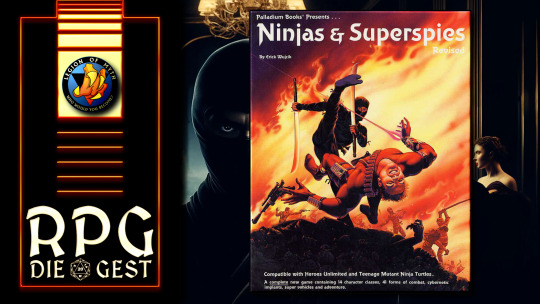
View On WordPress
#character skills rpg#legion of myth#martial arts in gaming#martial arts rpg#megaverse campaigns#megaverse settings#ninjas & superspies#ninjas and superspies review#ninjas in rpgs#Palladium Books#Palladium Fantasy#palladium game tutorials#palladium megaverse#palladium rpg strategies#Palladium universe#role-playing game guides#role-playing games#rpg character development#rpg combat techniques#rpg game design#rpg game mechanics#superspies game#tabletop combat#tabletop gaming tips#tabletop RPG
1 note
·
View note
Text
How Pixel Art Is Making Its Way Back Into Modern Gaming
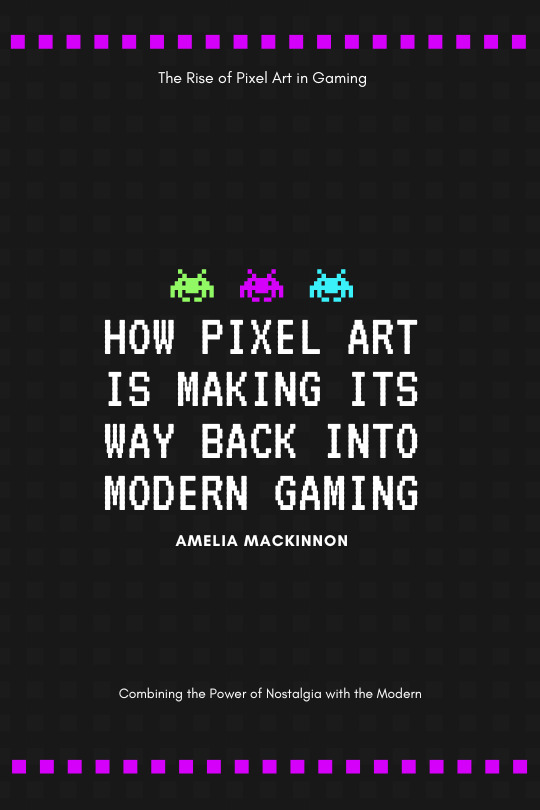
Trends come and go like shifting tides. However, one such trend is making its way back into modern gaming, captivating an entire industry: pixel art. Once relegated to the annals of gaming history, pixel art is making a comeback, injecting fresh life into contemporary game design. Let's dive into the reasons behind this resurgence and highlight some notable examples of games embracing every bit of nostalgia.
Rediscovering the Charm of Pixels
Pixel art, characterized by its blocky, pixelated aesthetic, evokes a sense of nostalgia for gamers who grew up in the golden era of gaming, including myself. From the 8-bit wonders of the 1980s to the 16-bit masterpieces of the 1990s, pixel art was the visual language that fueled countless adventures. However, as technology advanced, the allure of high-definition graphics overshadowed the simplicity and charm of pixel art.
Yet, as I...ahem...the gaming community matured, so too did the need for nostalgia. Gamers and developers alike began to appreciate the unique appeal of pixel art. Its minimalist yet expressive style allows for near-infinite creativity while invoking a sense of nostalgia that resonates across generations. Moreover, pixel art’s accessibility has democratized game development, enabling indie developers to craft visually stunning experiences with limited resources.
The Rise of Pixel Art in Gaming
In recent years, pixel art has experienced a renaissance, permeating all genres and platforms. Games like "Stardew Valley" by ConcernedApe and "Celeste" by Matt Makes Games have captivated audiences worldwide with their breathtaking pixel art visuals. These titles showcase the versatility of pixel art, transcending its nostalgic roots to deliver immersive and emotionally resonant experiences.
"Hyper Light Drifter" by Heart Machine is another standout example, blending fluid animation and intricate pixel art to create a mesmerizing world filled with mystery and danger. Meanwhile, "Undertale" by Toby Fox subverts traditional RPG conventions with its quirky characters and heartfelt storytelling, all rendered in charming pixel art.
Pushing the Boundaries of Pixel Art
While pixel art pays homage to gaming's past, it also pushes the boundaries of what's possible in modern game design. With advancements in technology and artistic techniques, developers are leveraging pixel art to create visually stunning and mechanically innovative experiences.
Games like "Dead Cells" by Motion Twin seamlessly blend pixel art with dynamic lighting and fluid animation, resulting in a visually striking and responsive gameplay experience. Similarly, "Cuphead" by Studio MDHR marries hand-drawn animation with classic 1930s cartoon aesthetics, breathing new life into the platformer genre.
Combining the Power of Nostalgia with the Modern
Among the rising stars of pixel art gaming is "Sea of Stars" by Sabotage Studio. Set in a vibrant world brimming with magic and adventure, "Sea of Stars" combines stunning pixel art visuals with deep, turn-based combat mechanics. Inspired by classic RPGs of yesteryears, the game promises to transport players on an epic journey filled with wonder and peril.
Conclusion
In an industry constantly chasing the next big trend, pixel art stands as a testament to the enduring power of simplicity and nostalgia. Its resurgence in modern gaming speaks to the timeless appeal of expressive visuals and immersive storytelling. As developers continue to explore the creative possibilities of pixel art, one thing is clear: the pixel art revolution is here to stay, enriching the gaming landscape with its timeless charm and boundless creativity.
#im a muffin#blog#pixel art#gaming#video games#sea of stars#nostalgia#jrpg#dead cells#cuphead#stardew valley#lgbtqiaplus
12 notes
·
View notes
Text
Inti Creates announces card-battling RPG Card-en-Ciel for PS5, Xbox Series, PS4, Xbox One, Switch, and PC
From Gematsu
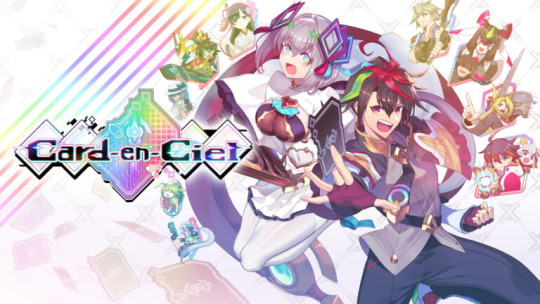
Inti Creates has announced Card-en-Ciel, a card-battling RPG for PlayStation 5, Xbox Series, PlayStation 4, Xbox One, Switch, and PC (Steam). A release date was not announced. It will support up to two players.
Get the first details below.
A Card-Battling RPG Through the Eras of Gaming!
Today, March 20, 2024, Inti Creates has announced a new project, Card-en-Ciel, to be shown at this week’s PAX East expo in Boston, Massachusetts from March 21 to 24.


Card-en-Ciel stars Neon, a gaming detective, as he collects and battles with over 300 cards on a deckbuilding RPG adventure.
Players will adventure through over 10 different dungeons, earning character cards to strengthen their deck and unlock new techniques to use in ever-expanding roguelite card battles.


Special “Muse Cards” add another layer to the card battles, activating powerful abilities with their songs during battle, with 50 vocal tracks included in-game.
Together with the Muses’ song abilities, players will use hidden card “glitches” and even enemies’ attacks against them to perform satisfying, full power combos with their unique decks.
Look for more information about Neon’s battles through the eras of gaming coming soon!
Famous Characters Are Invading an In-Development Game?!
Characters from other game universes are showing up in a work in progress! Can the detective Neon find the source?




Card-en-Ciel is a deck-building roguelike featuring over 300 unique cards and 50 vocal songs. Each card features a character from a game within the Card-en-Ciel universe, waiting to be collected and brought back from the game’s dungeons. You’ll need all the help you can get when the virtual world enters “all out war!”
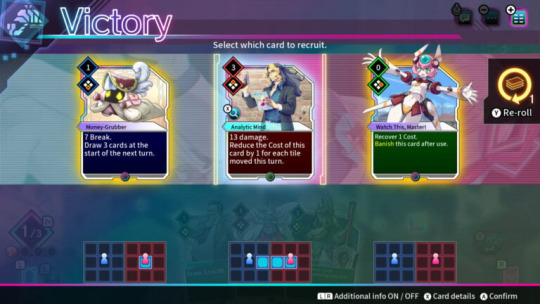
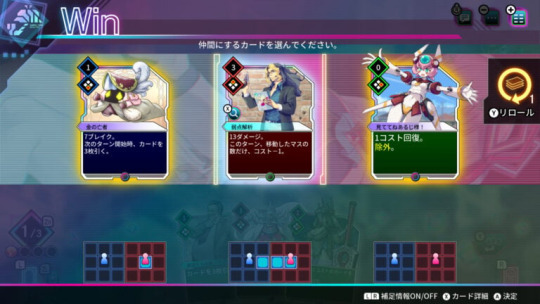

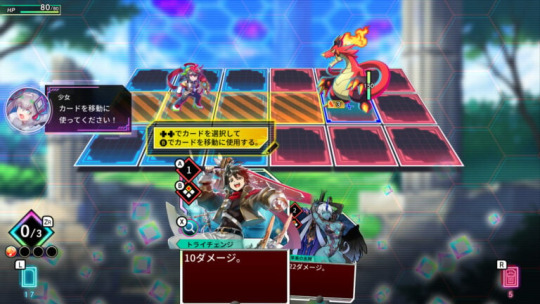
With each victory, you’ll select a card to add to your deck to power it up and create new combos. Each card can be played, used to move during battle, or for a Special Skill, allowing you to make the most of each draw from your deck within Card-en-Ciel‘s deep combat system!
Muse Cards add another layer to combat. Meet their conditions during battle, and they’ll sing a unique song that activates a special ability, unlocking new strategies and combos for the rest of your deck!
Use these powerful song abilities, hidden card “glitches,” and even your enemies’ attacks against them to perform satisfying, full power combos!


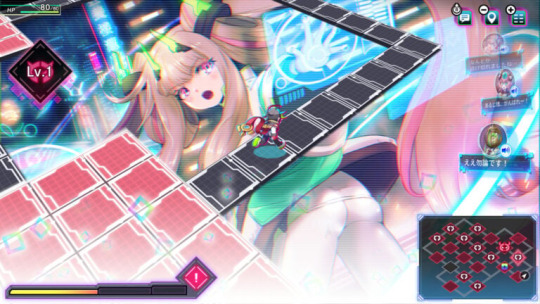

Colorful characters you meet in the dungeons, dungeon bosses, and the “imaginary” games they come from all play a part in Card-en-Ciel‘s story. Collect each game’s heroes and heroines to win the “all-out war!”
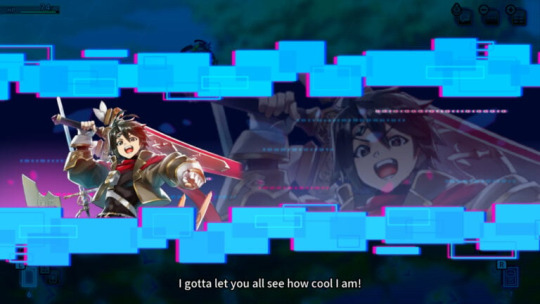

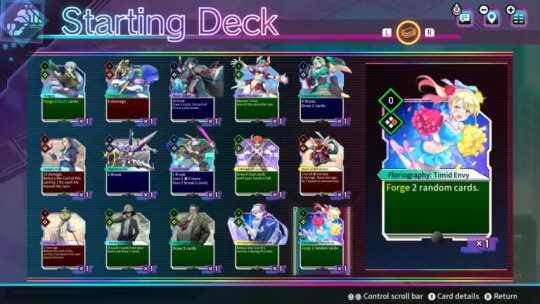

Product Information
Title: Card-en-Ciel
Platforms: PlayStation 5, Xbox Series, PlayStation 4, Xbox One, Switch, PC (Steam)
Genre: Card-Battling RPG
Rating: Pending
Players: 1 to 2
Release Date: TBA
Price: TBA

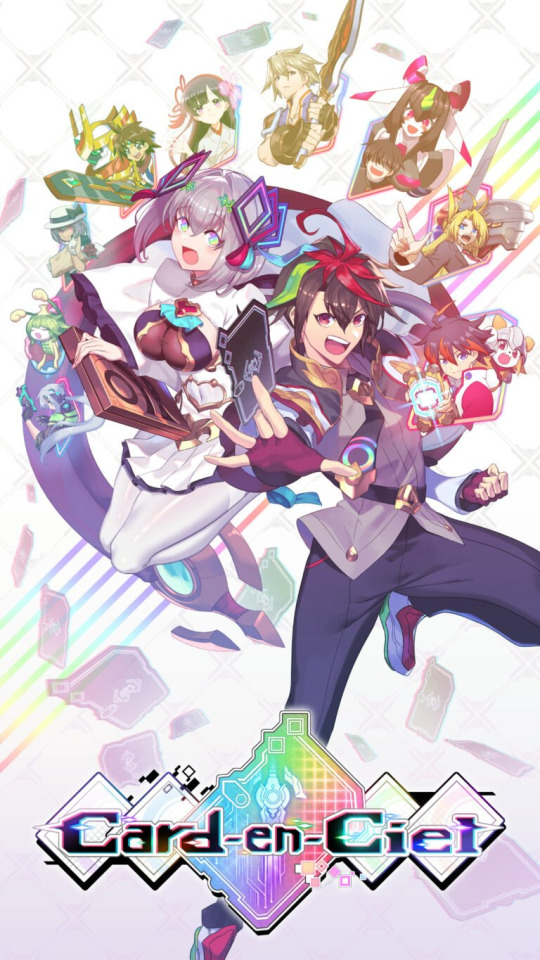
Watch the announcement trailer below. View the first screenshots at the gallery. Visit the official website here: English / Japanese.
Project Kickoff Trailer
English
youtube
Japanese
youtube
6 notes
·
View notes
Text
Avatar: Frontiers of Pandora
I will be the first ti admit I was skeptical going into the game. I was SUPER excited about it, but one of my friends played it before me and actually returned her copy. She said it was janky, repetitive, and unimagined. It was super disheartening to hear because she is also the biggest Avatar fan I know, if she didn't like the game then it must be bad.
But I kept it on my Christmas list and old Saint Nick delivered, and boy am I glad.
I literally love it.
Here's why:
- The world, the nature, PANDORA in all of its glory... it looks INCREDIBLE. The world feels so alive and vibrant compared to other games of the genre and even other games by the developer (Ubisoft)
- the characters, the NPCs, specifically Etuwa are all fantastic. They have interesting dialog, dialects, accents, mannerisms, looks, etc. I'm particularly fond of the "Crush" sidequest.
- The combat. The combat is nothing new for ubisoft, but this definitely feels like the best execution of this style they have been working on in a while. Absolutely love the two bows. And throwing bombs at RDA.
-Customization. At first the customization is very underwhelming, bit as you play you unlock hairstyles, paint patterns, all that fun stuff and I like to think of it as my character "growing" as she goes along her journey. Being able to "disguise" armor with the appearance of other armor should be mandatory in every game here on out.
-The ikran. Very rarely do games have a GOOD flight mechanic in them. They are always so junky (looking at GTA) and don't feel good. The Ikran flight however... fantastic. It feels so immersive, and you can really feel that this is a living thing you are flying and not a machine. The scenery is beautiful and even the air is filled with interesting things. No game has given me the adrenaline rush that jumping off of the Ikran nook and taking flight has given me.
- I could go on an on, but I will end it with design. The characters, the world, the biomes, the weapons, the animals, everything. It's vibrant, colorful, and alive. You can tell someone put a lot of detail into every aspect and it's awesome
CONS:
- There have been complaints the game is buggy. I personally haven't experienced any game breaking bugs, but I have had enough npc's not showing up to be considered annoying
- the player character voices. I'm sorry, I'm sure that the actors are talented, but none of their voices fit the player character. All of the Na'vi NPCs have unique voices and Na'vi accents. Even the Avatar characters have better Na'vi voices. The Serentu who is known to be closer to the human word, Teylan, has more of a natural voice. I cringe every time I hear my character speak. I will give them credit for having a nonbinary voice and character option tho (the NB voice is also the most tolerable by far)
- the game doesn't really add anything new. It is a very standard RPG, Ubisoft doesn't really explore new techniques and gimmicks all that much. It feels very much like a reskinned AC odyssey. Which isn't inherently a bad thing, I like AC odyssey, but I would like a little more innovation.
- you have to pay for the DLCs, even if you pre ordered. I can tell they released "half" the game and are essentially making you buy a "DLC" to get the other half. It's a single player RPG (mostly) enough with the pay-per-use and "season pass"
So TLDR: if you like Avatar, and Pandora, and exploration, this game is for you. If you want to fly around, taking down helicopters and help restore the planet, you will love this game
If you are looking for the next Elden Ring, or fill-in for Baldur's Gate, you will find it underwhelming, and plain.
Rating so far
8.5/10
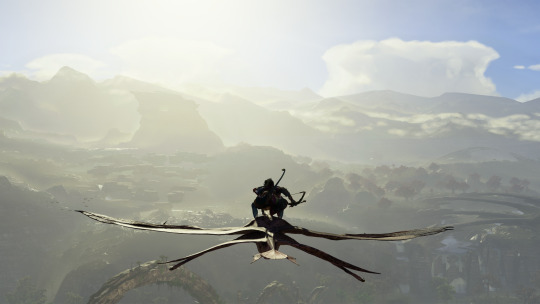
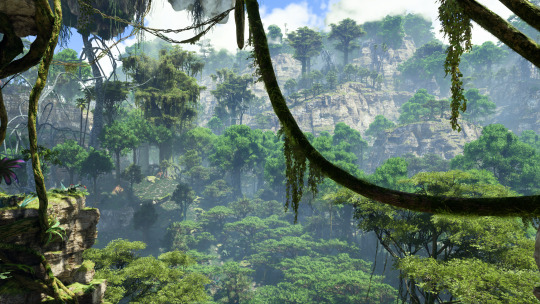


#avatar#frontiers of pandora#videogames#Na'vi#video games#gaming#xbox#the way of water#omatikaya#ikran#direhorse#gaming take
8 notes
·
View notes
Text
GODHAND, a brand new D20 TTRPG
Hello everyone! We are Five Elements Publishing, the creators of GODHAND. GODHAND, as the title of this post suggests, is a brand new D20-based tabletop roleplaying game of epic fantasy in which players use arcane magic, powerful fighting techniques, and quick wit to climb the ladders of mortality in the pursuit or rejection of TRUE DIVINITY. It is a game about causality, faith, and most importantly, power; the devotion to it, the repudiation of it, the need to cling to it, and what all of these things may do to a person's soul.
For nearly the past year, we have been working hard on a system that we can be proud of, born from a simultaneous love of tabletop RPGs and a disappointment with the current offerings on the table. We wanted to set out to make a game that *we* wanted to play, and finally, we're happy to say we have finished enough of our game that maybe other people will want to play it, too.
Following the linktr.ee to our Discord, you'll be able to download (for free) the current playtest version of GODHAND. This playtest version is, in its current state, a fully playable game, with:
- 4 classes
- 9 subclasses
- 17 monsters
- More than 90 spells
- Rules for character creation, including 8 Folk, 2 Bloodlines, and rules for half-Folk and adopted characters
- Combat rules which emphasize quick, yet highly in-depth and tactical gameplay
- 120+ pages of content Our goal was to create a game which was snappy and easy to play, but which didn't compromise on the depth of its mechanics. So far, we're happy with what we've made. Before I close out this post, you might be wondering just who "we" are. We are just a group of 5 people; 3 designers, 1 web designer and formatting specialist, and 1 artist. We made this game in our spare time; after work, between classes, and in our free time on the weekends. Most of us have full-time jobs. We are not industry veterans nor professionals... but it's our dream to be someday! We hope that you give us and GODHAND a fair shake, and that you'll keep an eye out for what's to come. We'll see you in the Discord! - MasterCat
https://linktr.ee/five_elements
14 notes
·
View notes